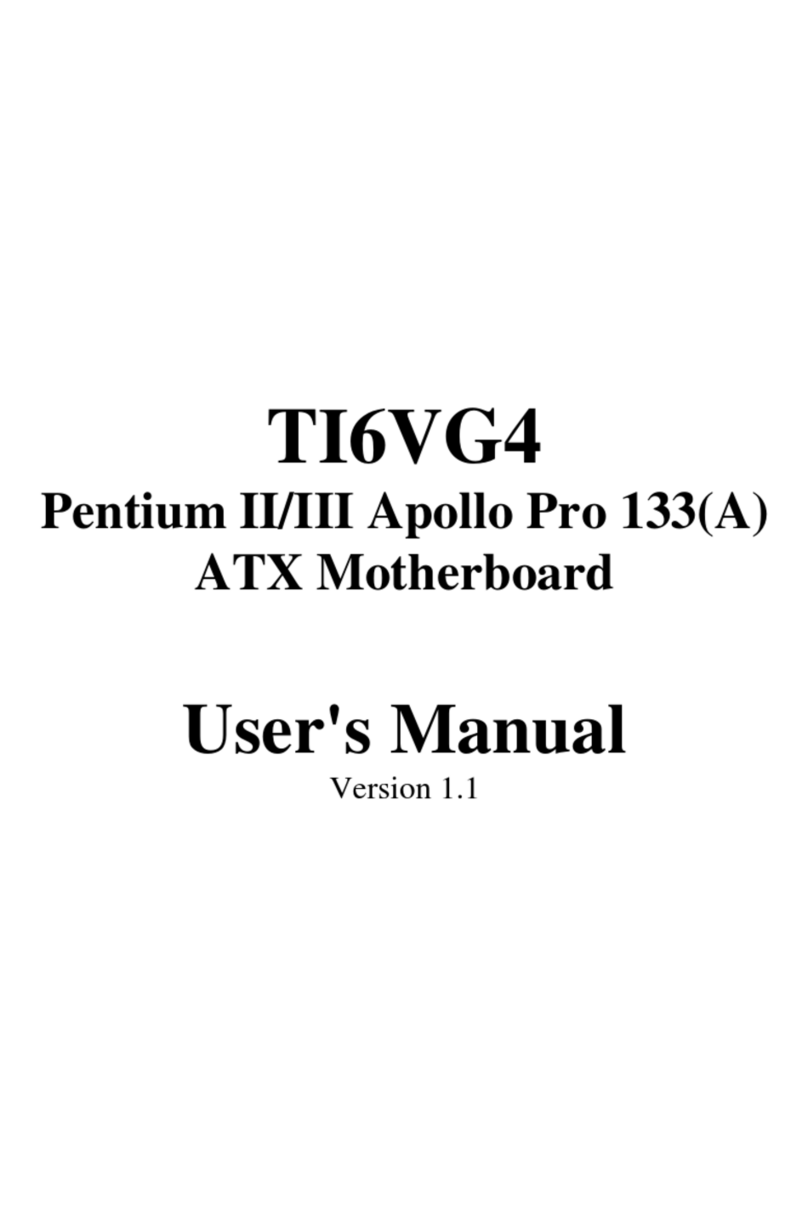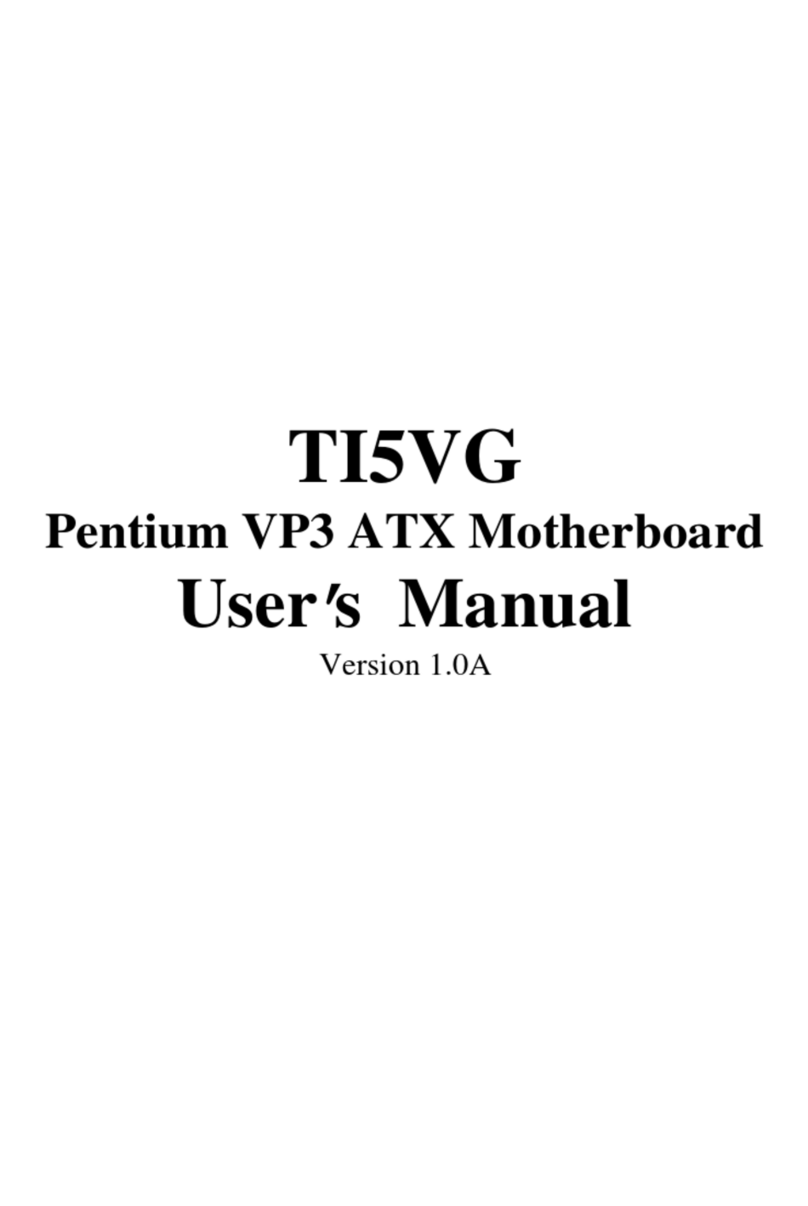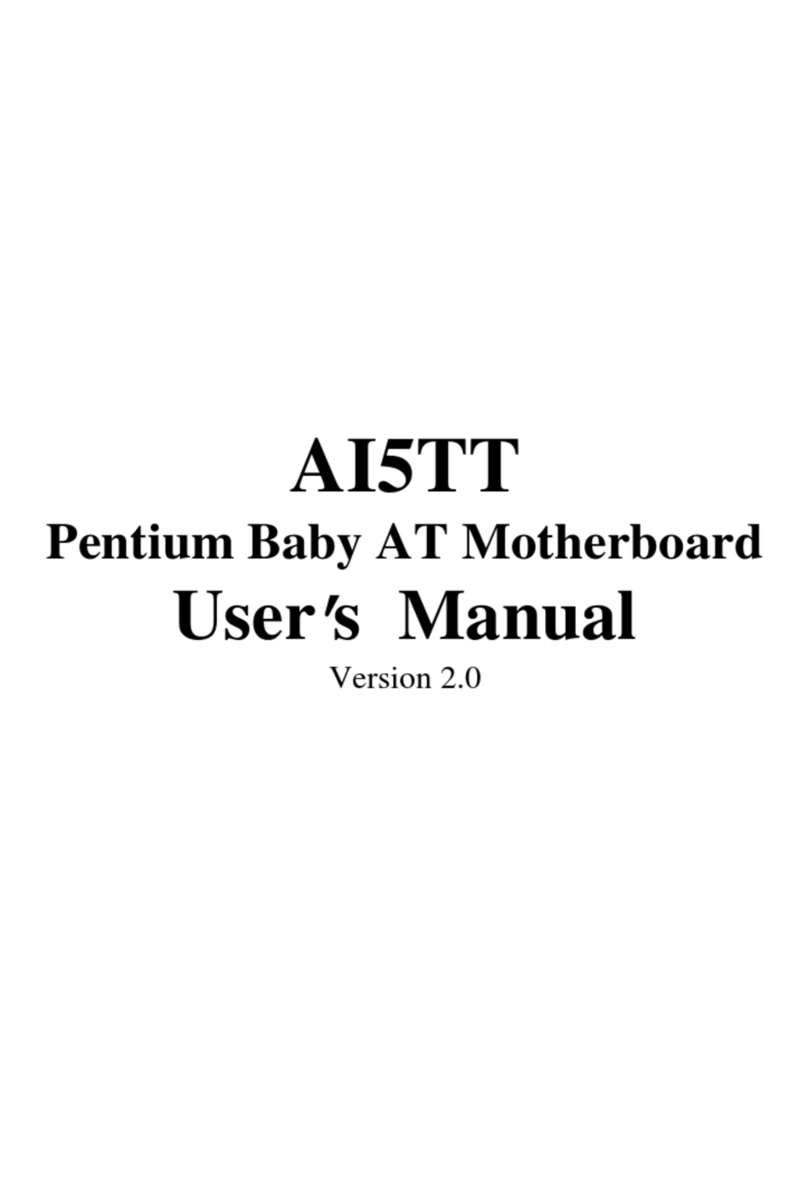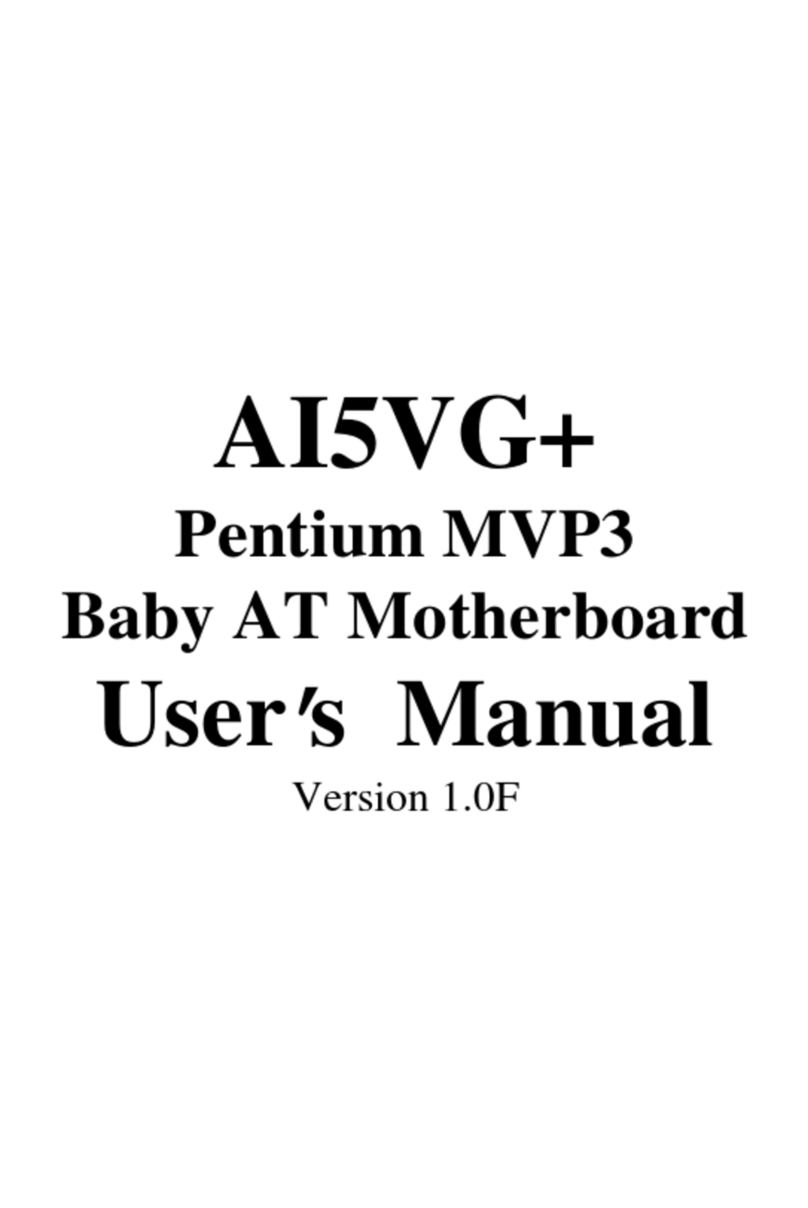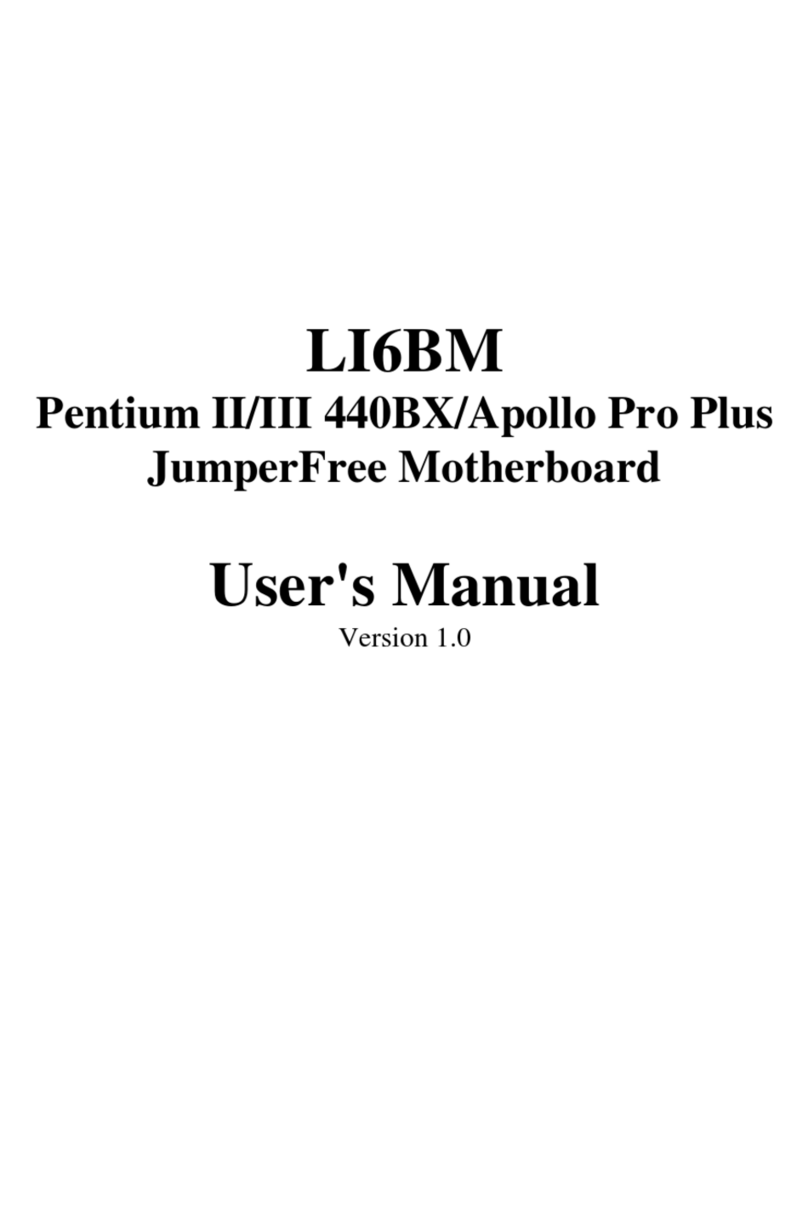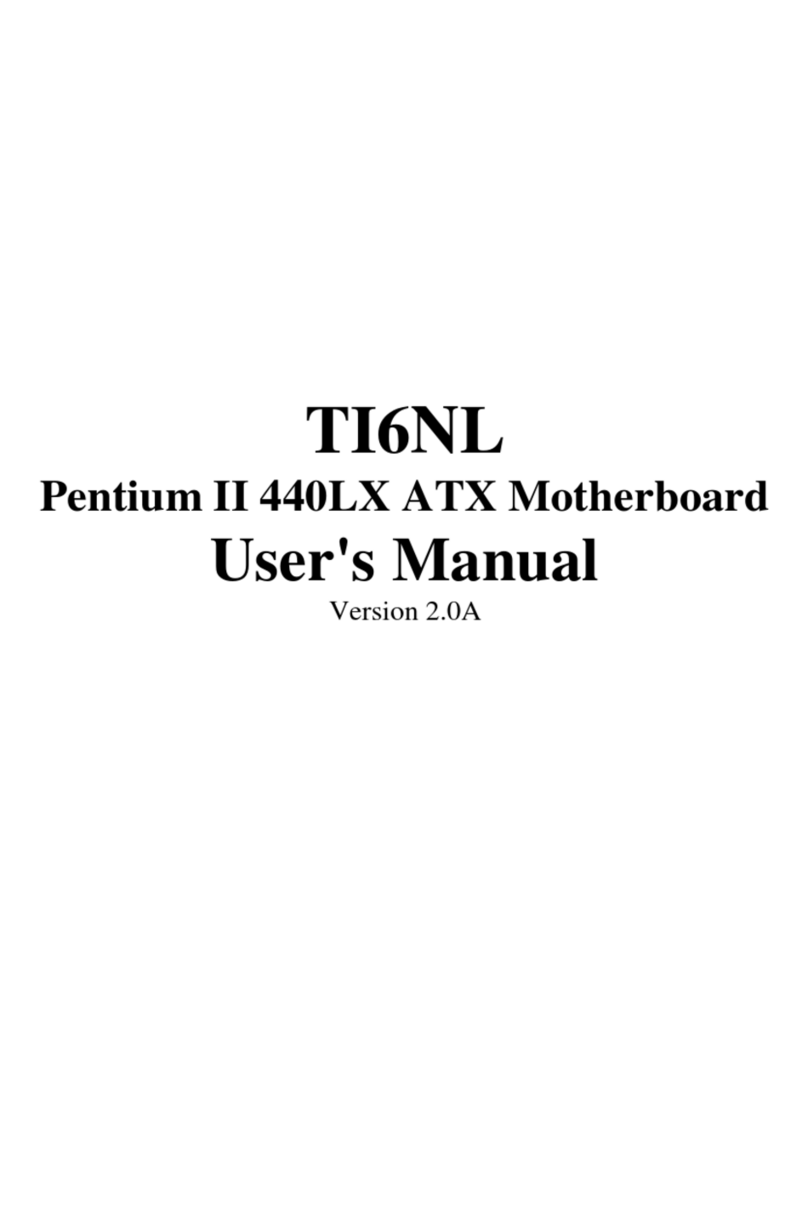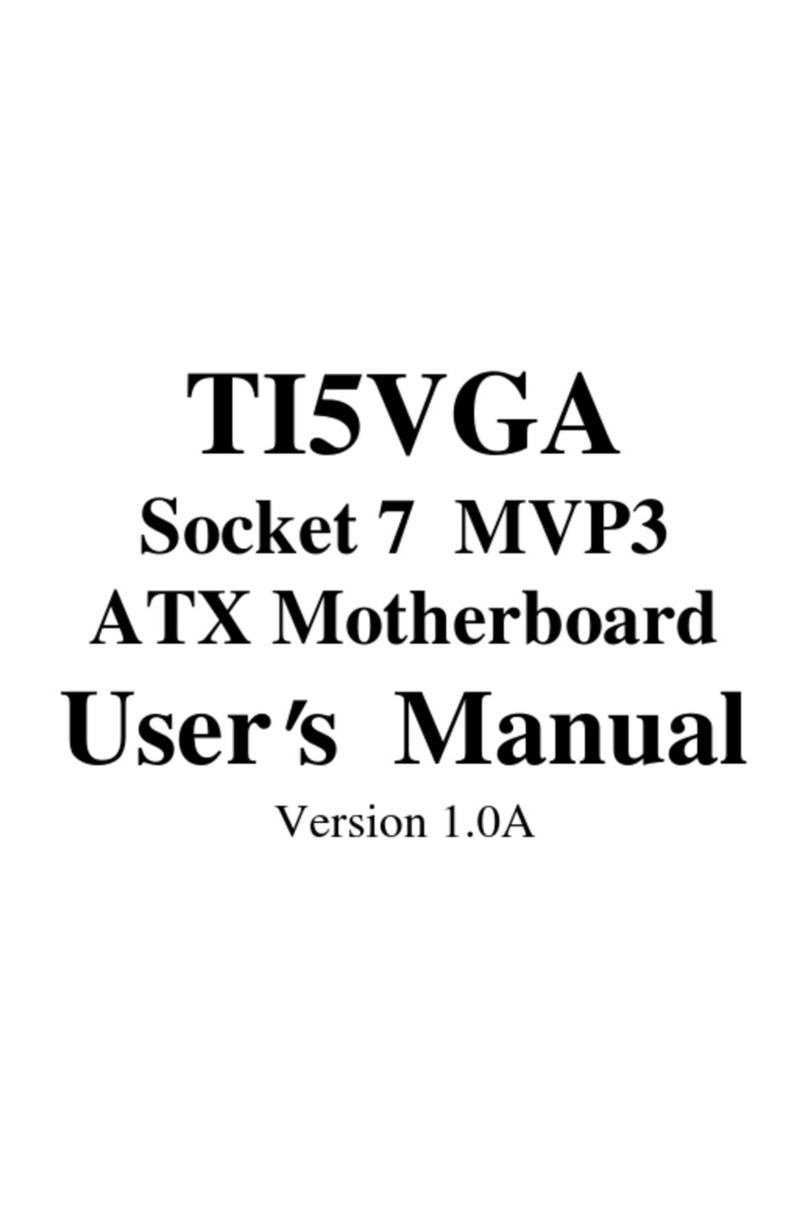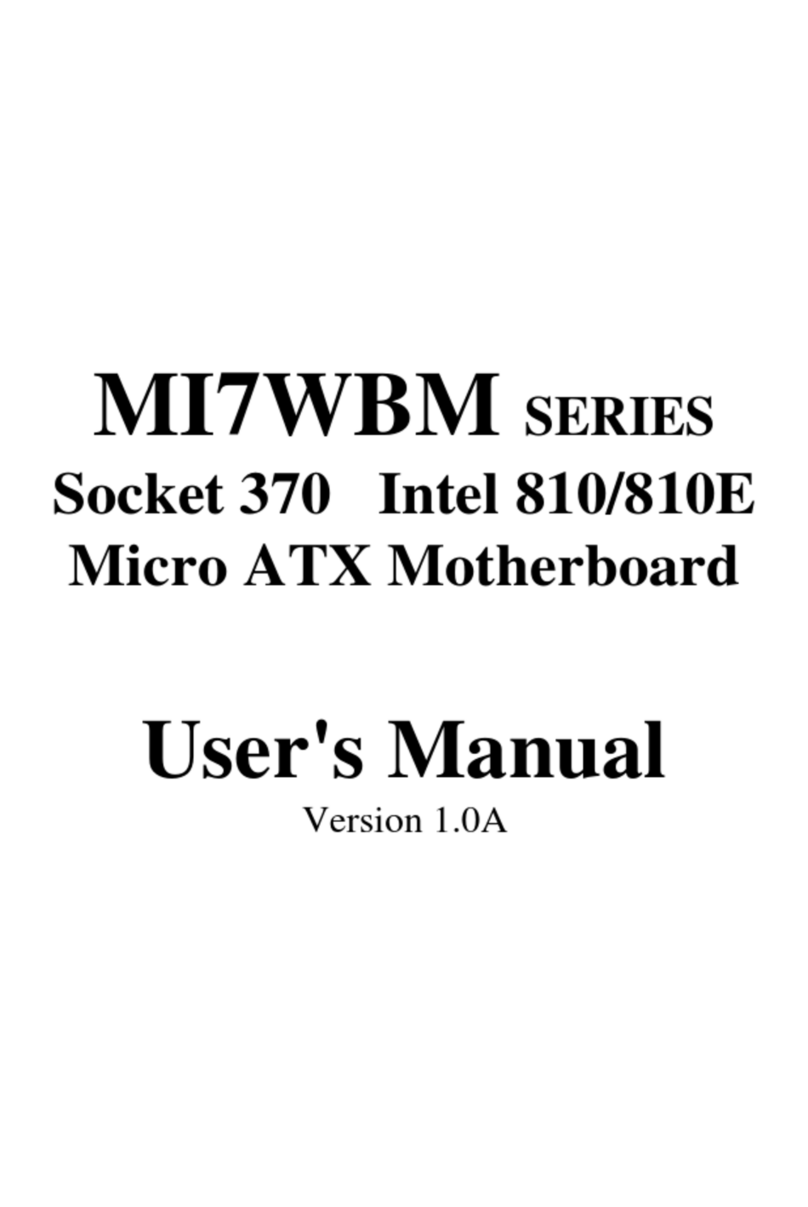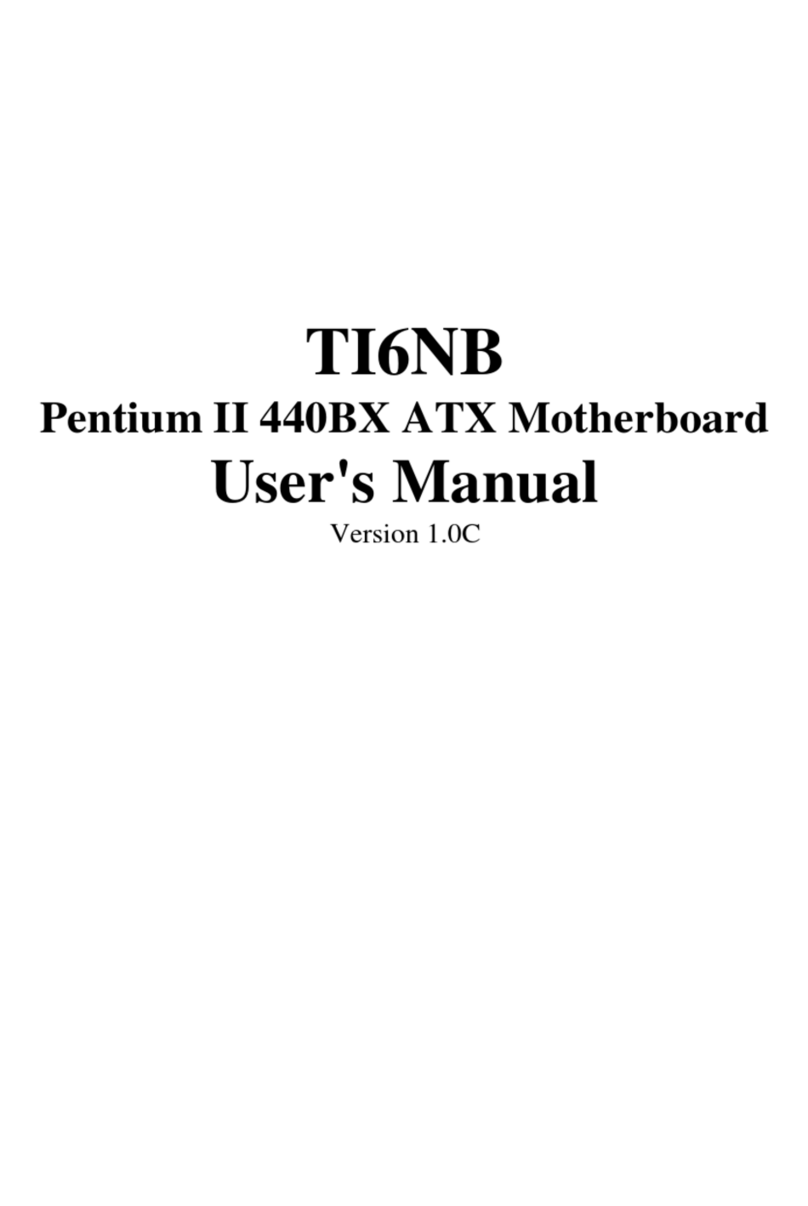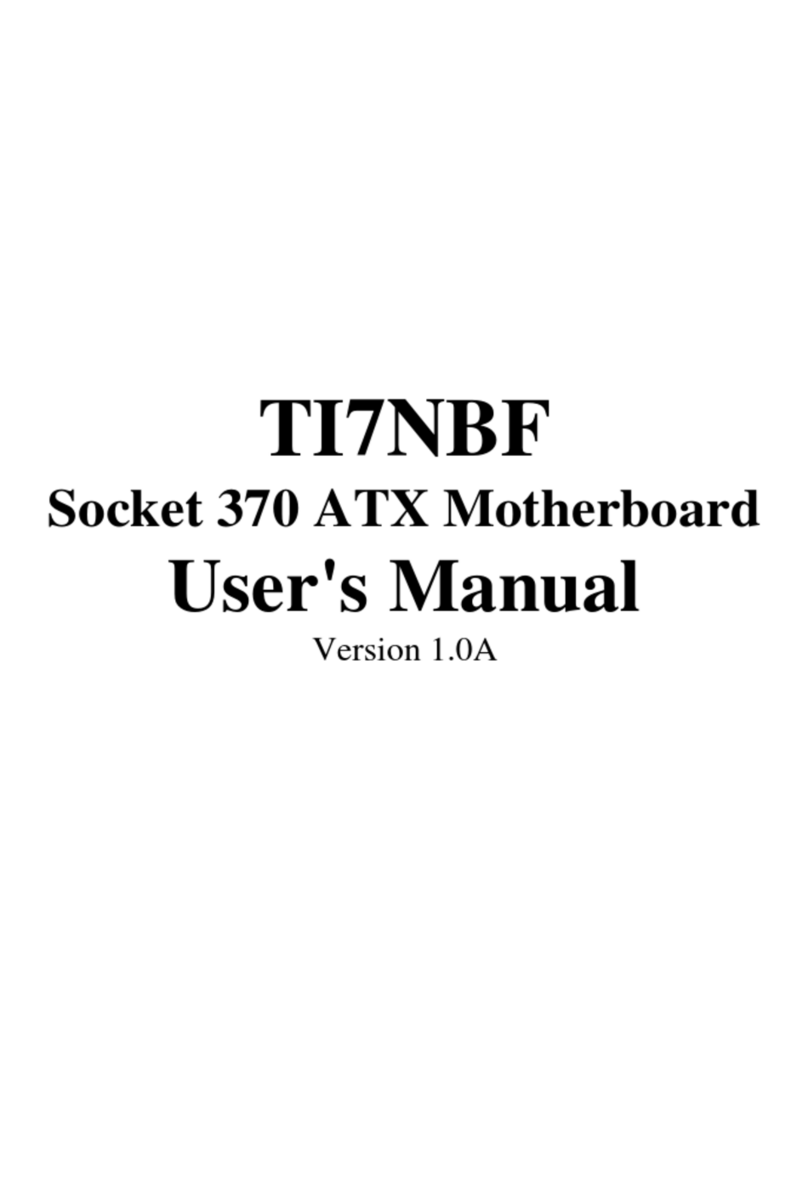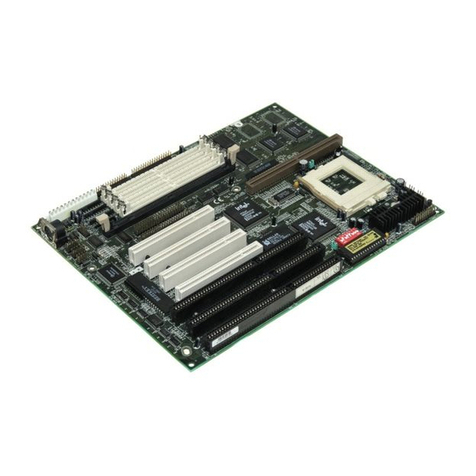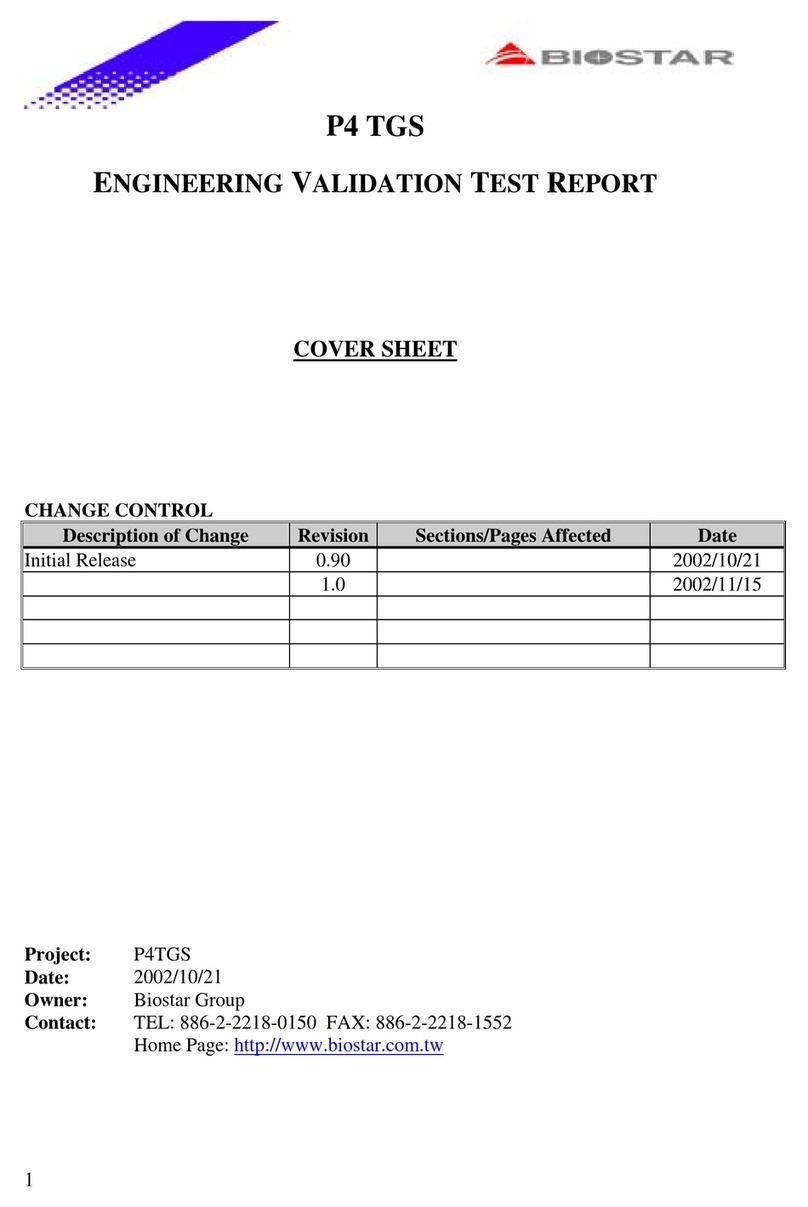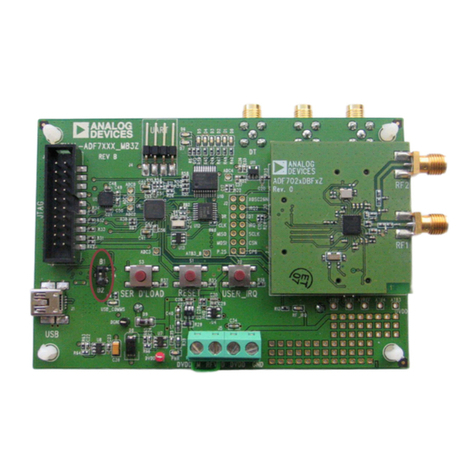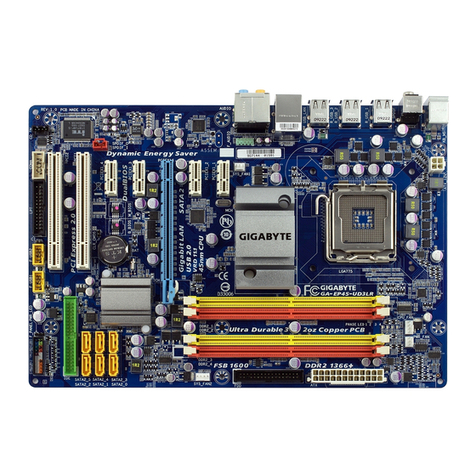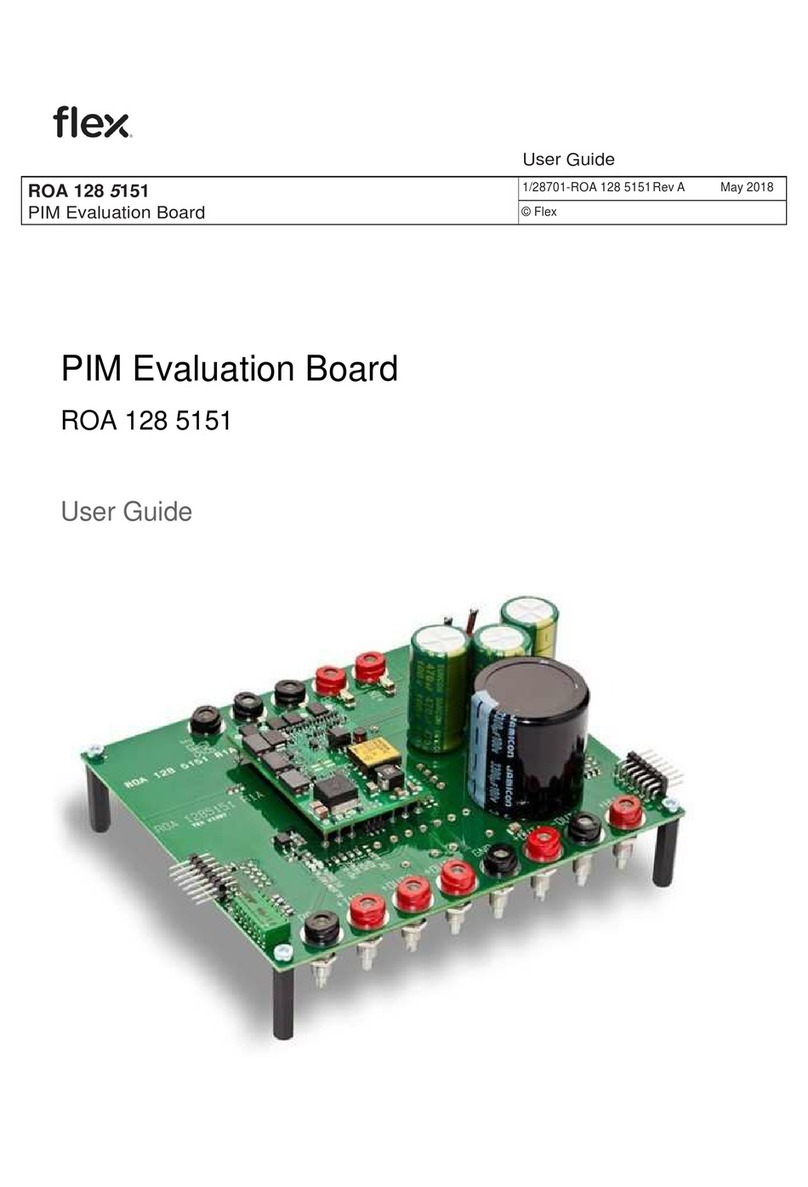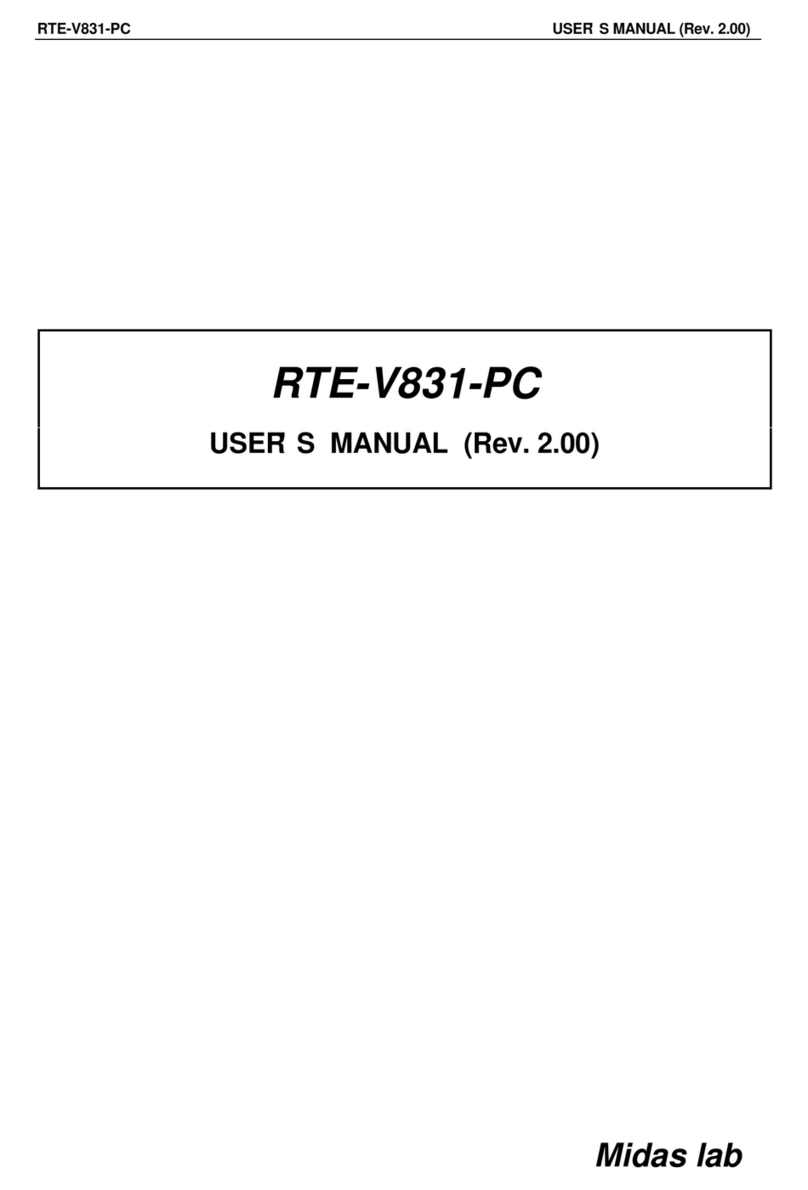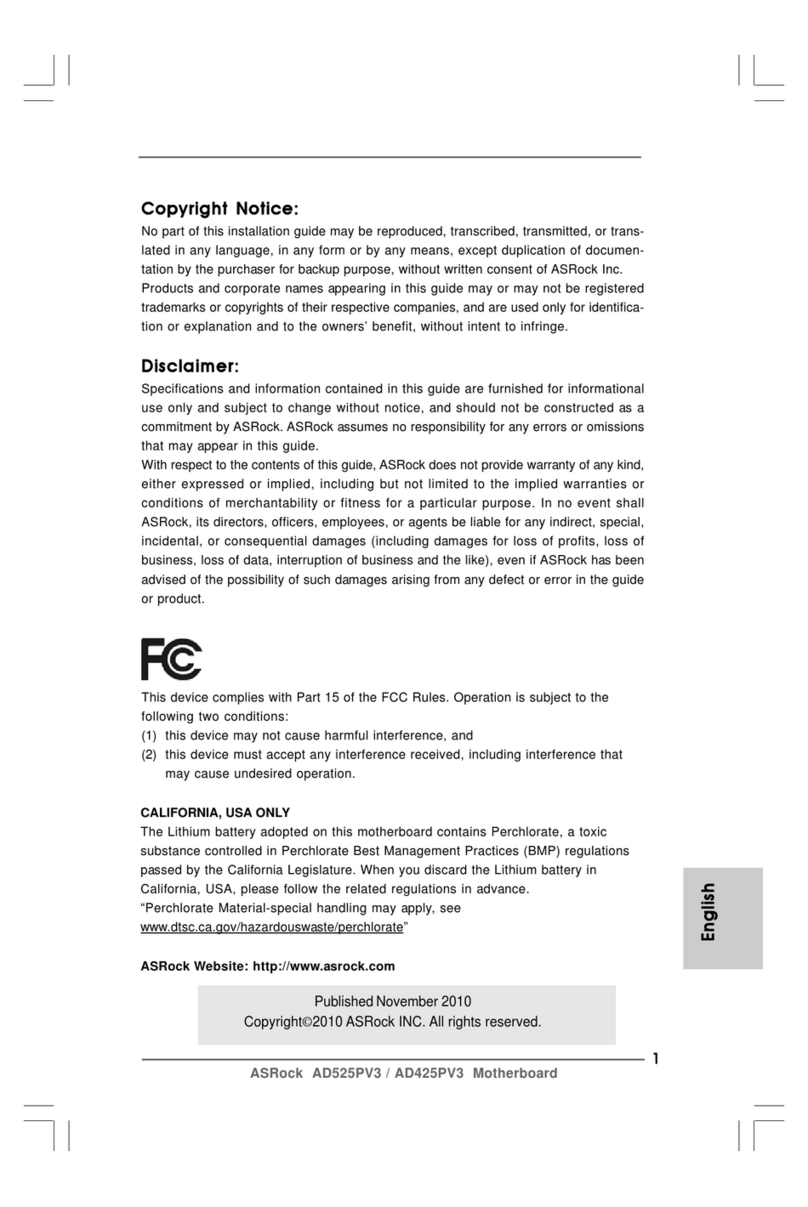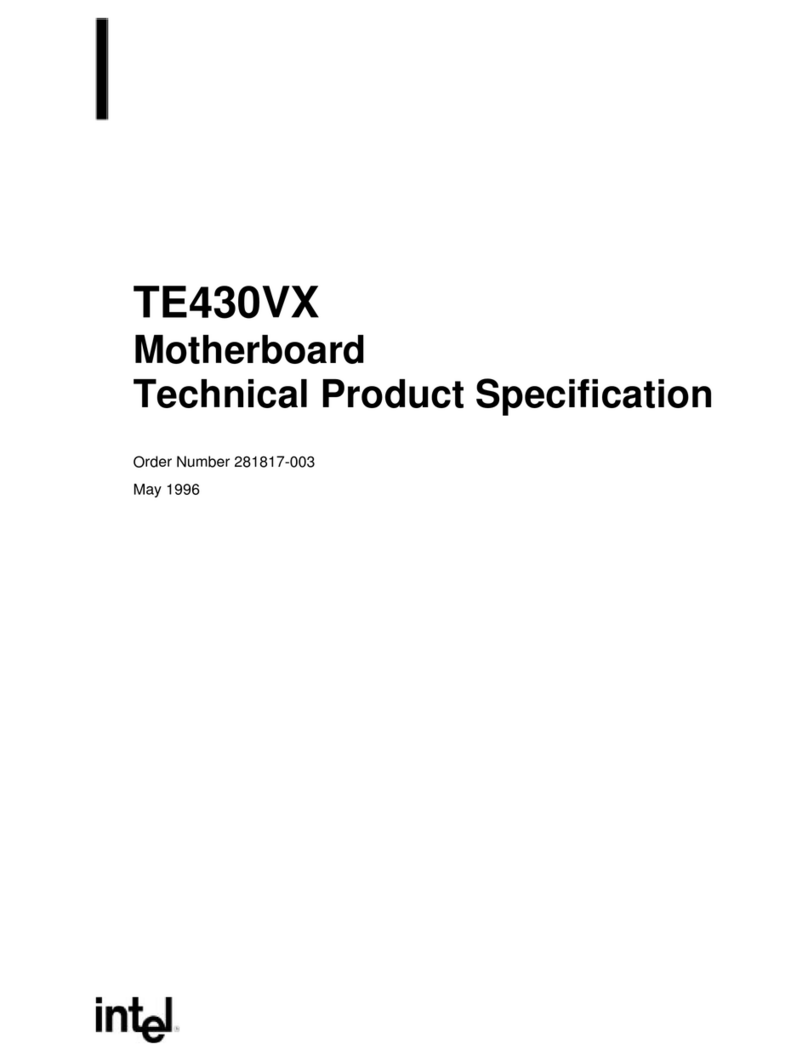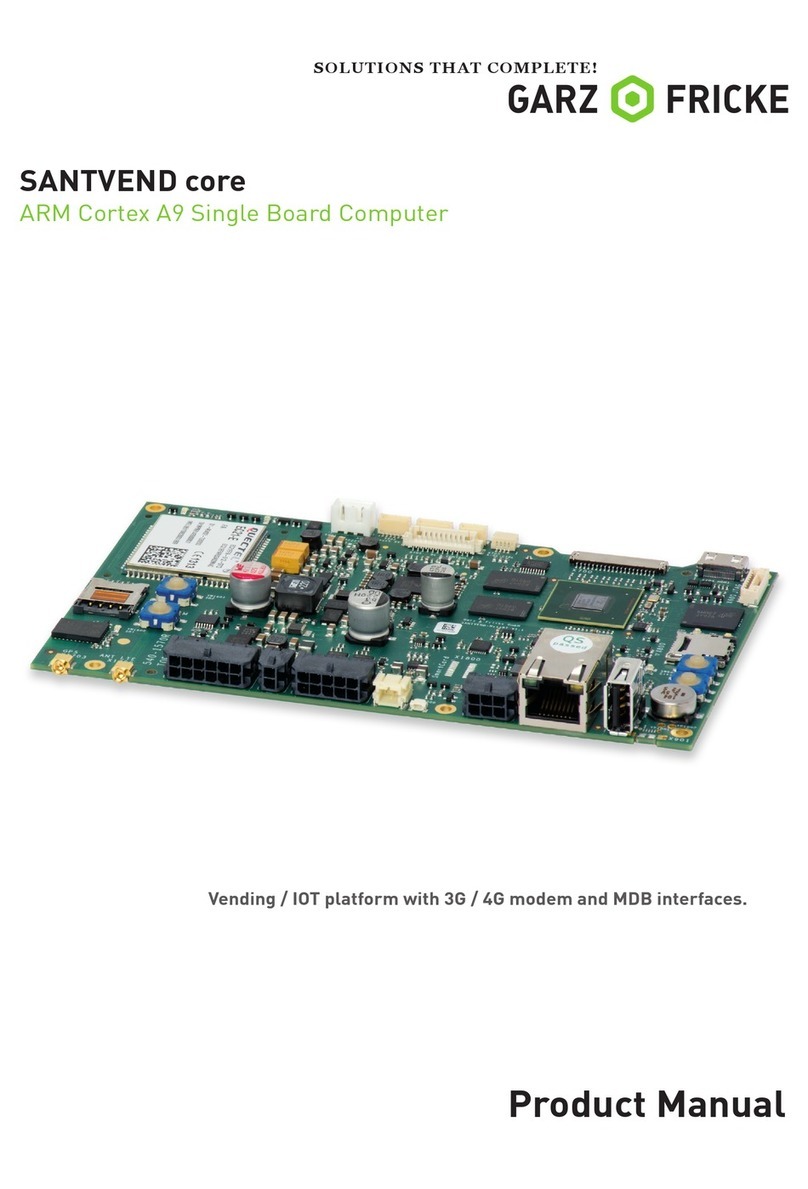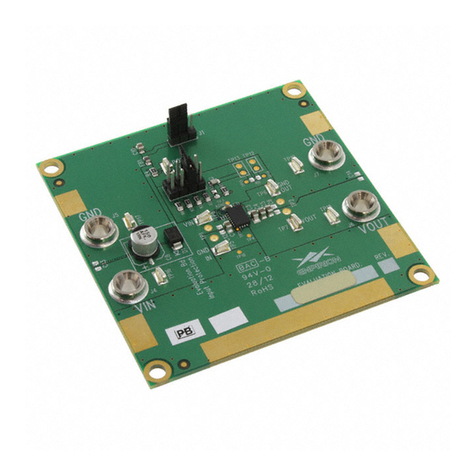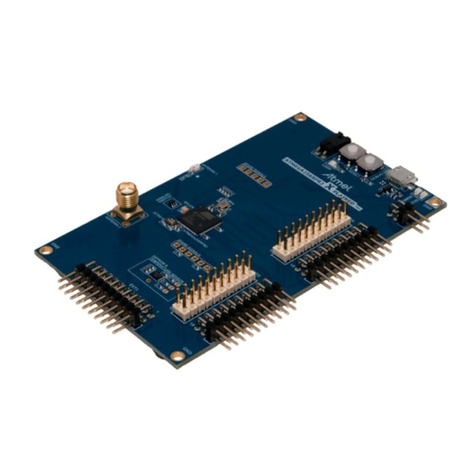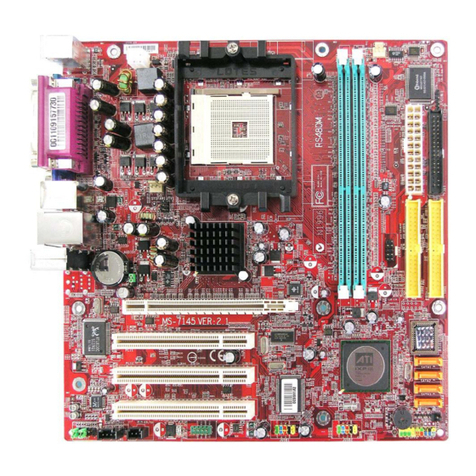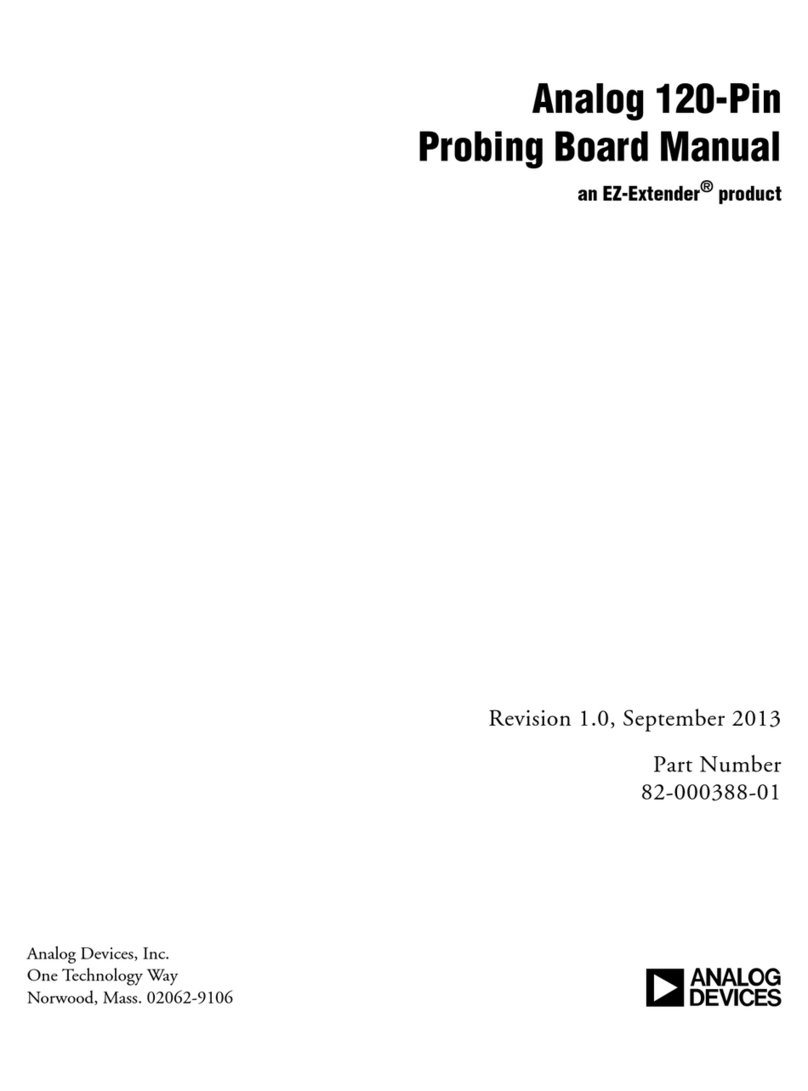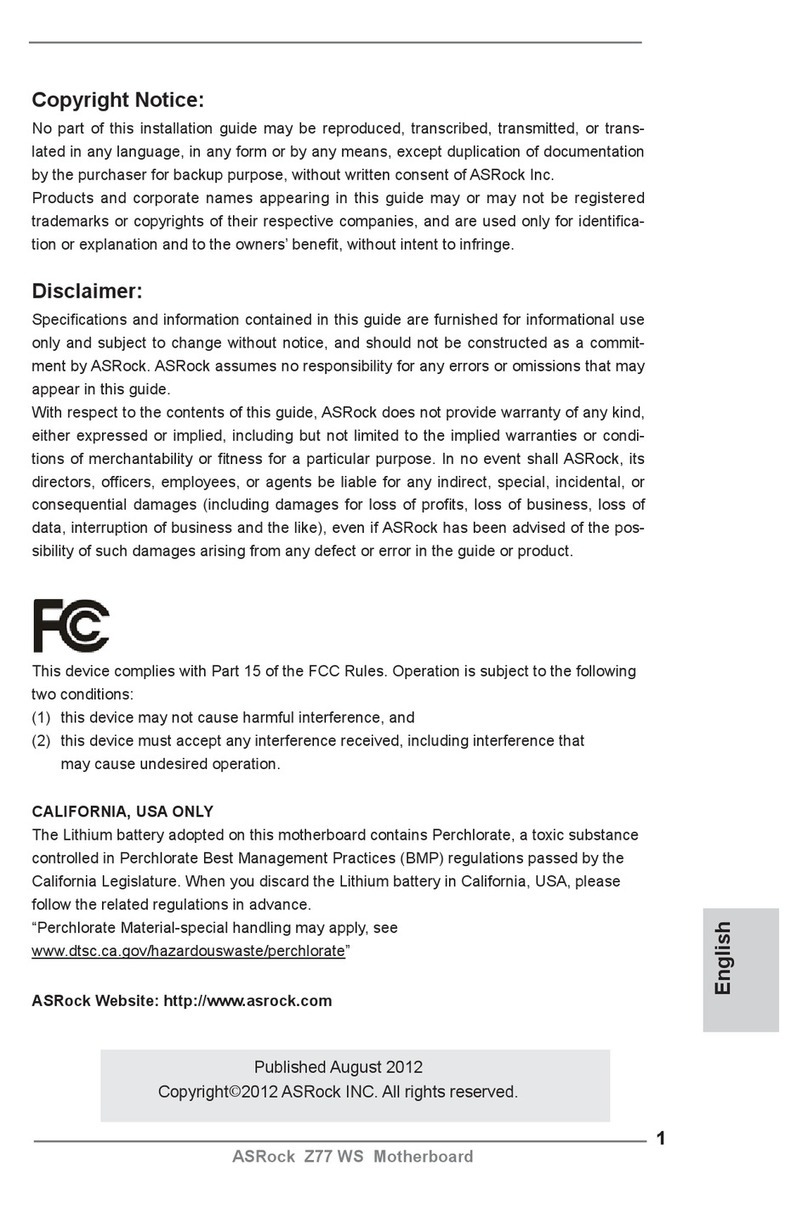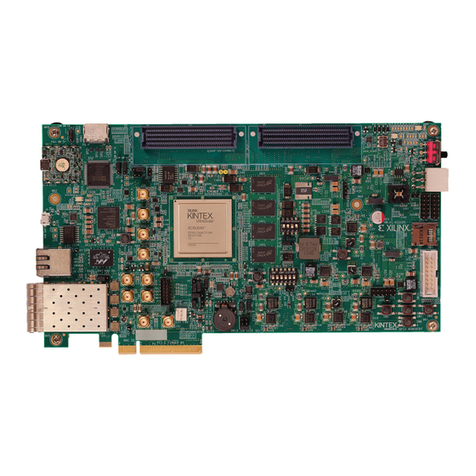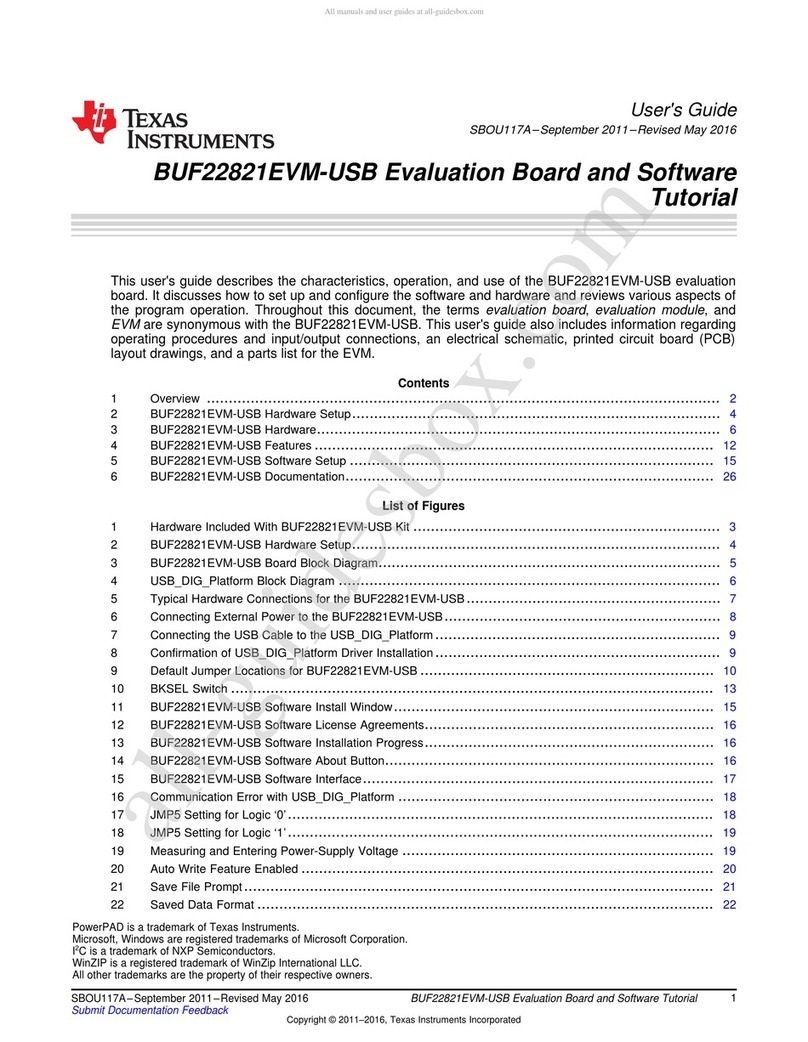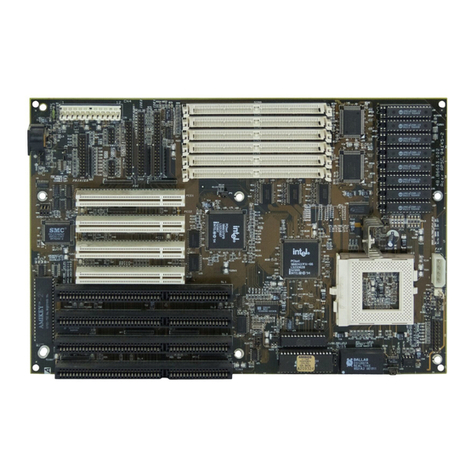TMC MI5VP4 User manual

MI5VP4
MVP4 Micro ATX Motherboard
User's Manual
Version 1.1

ii MI5VP4 User’s Manual
Copyright Notice
This publication is protected by copyright and all rights are reserved. No
part of it may be reproduced or transmitted by any means or in any form,
without prior consent of the original manufacturer.
The information in this document has been carefully checked and is
believed to be accurate. However, the original manufacturer assumes no
responsibility for any inaccuracies that may appear in this manual. In no
event will the original manufacturer be liable for direct, indirect, special,
exemplary, incidental, incidental or consequential damages resulting
from any defect or omission in this manual, even if advised of possibility
of such damages. The material contained herein is for informational
purposes only.
Acknowledgments
Award is a registered trademark of Award Software International, Inc.
PS/2 is a trademark of International Business Machines Corporation.
Intel and Pentium are registered trademarks of Intel Corporation.
MVP4 is a trademark of VIA Technologies.
Microsoft Windows is a registered trademark of Microsoft Corporation.
All other product names or trademarks are properties of their respective
owners.

Contents
MI5VP4 User’s Manual iii
Contents
Chapter 1 Introduction....................................................1
Chapter 2 Specifications..................................................3
Chapter 3 Hardware Description ...................................5
3.1 Processor ...................................................................................7
3.2 L2 Cache ...................................................................................7
3.3 Main Memory............................................................................7
3.4 BIOS..........................................................................................9
3.5 Onboard VGA...........................................................................9
3.6 Hardware Monitoring................................................................9
3.7 Onboard Multi-I/O ....................................................................9
3.8 Interrupt Request (IRQ) Lines.................................................10
3.9 Onboard PCI-IDE....................................................................10
3.10 DMA Channels......................................................................10
3.11 I/O Port Address Map............................................................11
3.12 Onboard Audio......................................................................11
Chapter 4 Configuring the Motherboard ....................13
4.1 SW1(4-8): CPU Voltage Setting.............................................15
4.2 SW2(1-4): CPU Bus Speed/FSB Selector...............................16
SW1(1-3): CPU Bus Speed Multiplier....................................16
4.3 JP2: Clear CMOS Select .........................................................20
Chapter 5 Installation....................................................21
5.1 I/O Connectors ........................................................................23
5.2 J1: PS/2 Keyboard and PS/2 Mouse Connectors.....................23
5.3 J2: USB Connector..................................................................24
5.4 J3, J12: Serial Ports.................................................................24
5.5 J4: Parallel Port Connector......................................................25
5.6 J5: VGA Port Connector .........................................................25
5.7 J6, J7, J8, J9: Line Out, Line In, Mic In, Game Port...............26
5.8 J10: CPU Fan Power Connector..............................................26
5.9 J11: ATX Power Supply Connector........................................26
5.10 J14, J16: CD-ROM Audio In Connectors..............................27
5.11 J17: Wake on LAN Connector ..............................................27

Contents
iv MI5VP4 User’s Manual
5.12 J18: IrDA Connector..............................................................28
5.13 J19: Chassis Fan Power Connector........................................28
5.14 J20: Front Bezel Connectors..................................................29
5.15 J21: Floppy Drive Connector.................................................31
5.16 J23, J22: EIDE Connectors....................................................32
Chapter 6 BIOS Configuration.....................................33
6.1 BIOS Introduction ...................................................................36
6.2 BIOS Setup..............................................................................36
6.3 Standard CMOS Setup.............................................................38
6.4 BIOS Features Setup................................................................41
6.5 Chipset Features Setup.............................................................44
6.6 Power Management Setup .......................................................47
6.7 PNP/PCI Configuration ...........................................................50
6.8 Load BIOS Defaults ................................................................52
6.9 Load Setup Defaults.................................................................52
6.10 CPU Features Setup...............................................................53
6.10 Integrated Peripherals............................................................54
6.11 Supervisor / User Password...................................................56
6.12 IDE HDD Auto Detection......................................................57
6.13 Save & Exit Setup..................................................................58
6.14 Exit Without Saving...............................................................58
Chapter 7 VIA Drivers Installation Guide ..................59
7.1 Windows 98 4-in-1 Driver Installation....................................59
7.2 Windows 98/95 DirectX Installation.......................................65
7.3 Windows 98/95 VGA Driver Installation................................67
7.4 Windows 98 Audio Driver Installation....................................69
7.5 Windows 95 VXD Driver Installation.....................................71
7.6 Windows 95 VIA IDE Bus Master Driver Installation............73
7.7 Windows 95 Audio Driver Installation....................................77
7.8 Windows NT 4.0 VGA Driver Installation..............................78
7.9 Windows NT 4.0 Audio Driver Installation.............................80
Appendix..........................................................................81
A. Additions & Errata....................................................................81

Chapter 1 Introduction
MI5VP4 User’s Manual 1
Chapter 1 Introduction
This manual is designed to give you information on the MI5VP4
motherboard. It is divided into the following sections:
•
••
•
Introduction
•
••
•
Specifications
•
••
•
Hardware Description
•
••
•
Configuring the Motherboard
•
••
•
Installation
•
••
•
BIOS Configuration
•
••
•
VIA Drivers Installation Guide
Checklist
Please check that your package is complete and contains the items below.
If you discover damaged or missing items, please contact your dealer.
The MI5VP4 Motherboard
1 IDE ribbon cable
1 floppy ribbon cable
1 COM port ribbon cable
1 CD containing a system monitoring utility, drivers for the
onchip VGA, onchip audio and Bus Master IDE driver and
utilities.
Note: The ATA-66 IDE cable that is used in conjunction with Ultra
DMA/66 hard disks is optional. Refer to the figure below on how to
connect the cable.

Chapter 1 Introduction
2MI5VP4 User’s Manual
This page was intentionally left blank.

Chapter 2 Specifications
MI5VP4 User’s Manual 3
Chapter 2 Specifications
The MI5VP4 is a high-performance Micro ATX MVP4 motherboard
with a Socket 7 connector for Socket 7-level processors. The
VT82C686A chip that comes with the MVP4 chipset has built-in multi
I/O, VGA, audio and hardware monitoring functions. The motherboard
offers flexibility in terms of CPU frequency and main memory type and
size. The main features of the motherboard consist of the following:
CPU Socket
Socket 7
System Speed
120~500MHz
Bus Speed
60~124MHz
Processor
Intel Pentium 120/133/150/166/200
Intel Pentium MMX (P55C) 120/133/150/166/200/233
Cyrix 6x86/6x86L P150+/P166+/P200+
Cyrix 6x86MX PR166/PR200/PR233/PR266
Cyrix 6x86MII PR266/PR300/PR333/PR366
AMD K5 PR100/PR133/PR166
AMD K6 166/200/233/266/300
AMD K6-2/300/333/350/400/450/500
AMD K6-3/400/450/500/550
IDT WinChip C6 180/200/225MHz
IDT WinChip2-3D C6 200/225/266/300MHz
L2 Cache
1MB or 2MB
Main Memory
Three 168-pin DIMM sockets
Memory types: Extended Data Output (EDO) DRAM, SDRAM
(Synchronous DRAM)
Memory size: 32MB, 64MB, 128MB
Chipset
VIA’s VT82C686A chipset with built-in PCI-IDE

Chapter 2 Specifications
4MI5VP4 User’s Manual
Super I/O
Built-in VIA’s VT82C686A chip
z
Two 16550 UART compatible serial ports
z
One parallel port (ECP/EPP compatible)
z
One floppy controller (2.88MB compatible)
z
One IrDA port
PCI Bus Master IDE Controller (Ultra DMA/66)
The onboard VIA chipset’s PCI Bus Master IDE (Ultra DMA/66)
controller with two connectors for up to four IDE devices in two
channels, supporting enhanced IDE devices such as tape backup and
CD-ROM drives, PIO Mode 3/4 and Bus Mastering Ultra DMA/66
NOTE: A UDMA66 cable should be used for UDMA66 interface.
Under Windows NT 4.0, you need to install Windows NT
Service Pack 4.)
BIOS
Award BIOS with ISA Plug and Play (PnP) extension, DMI, bootable
CD-ROM and power-management features. The BIOS is Y2K (Year
2000) compliant.
Mouse Connector
PS/2 type
Keyboard Connector
PS/2 type
USB Connector
2 ports on board
Win95-shut-off
Allows shut-off control from within Windows 95
Onboard Audio
Built-in VIA’s VT82C686A
The onboard audio is fully compatible with Sound Blaster Pro
compliant with Intel PC97 specifications.
Expansion Slots
Four 32-bit PCI slots
One 16-bit ISA slots
Form Factor
Micro ATX, 9.45” x 8.27 (24cm x 21cm)

Chapter 3 Hardware Description
MI5VP4 User’s Manual 5
Chapter 3 Hardware Description
This chapter briefly describes each of the major features of the MI5VP4
motherboard. The layout of the board in Figure 1 shows the location of
the key components. The topics covered in this chapter are as follows:
3.1 Processor ...................................................................................7
3.2 L2 Cache ...................................................................................7
3.3 Main Memory............................................................................7
3.4 BIOS..........................................................................................9
3.5 Onboard VGA...........................................................................9
3.6 Hardware Monitoring................................................................9
3.7 Onboard Multi-I/O ....................................................................9
3.8 Interrupt Request (IRQ) Lines.................................................10
3.9 Onboard PCI-IDE....................................................................10
3.10 DMA Channels......................................................................10
3.11 I/O Port Address Map............................................................11
3.12 Onboard Audio......................................................................11

Chapter 3 Hardware Description
6MI5VP4 User’s Manual
Figure 1: Layout of the MI5VP4 Motherboard

Chapter 3 Hardware Description
MI5VP4 User’s Manual 7
3.1 Processor
The MI5VP4 motherboard is designed to take Socket 7 processors with
system speed of 120MHz to 500MHz at a bus speed of 60MHz to
124MHz. To be able to use the your processor with the motherboard
properly, DIP switches on the motherboard should be configured
correctly. Two DIP switches are available to configure the CPU voltage,
bus speed (front side bus), and bus speed multiplier. Please refer to the
following chapter on how to configure the CPU frequency.
3.2 L2 Cache
The L2 cache is integrated in the processor.
3.3 Main Memory
The MI5VP4 motherboard supports three 168-pin DIMM (Dual In-line
MemoryModule) sockets to forma memory configuration from 32MB to
384MB. DIMM modules can be 32MB, 64M and128MB in SDRAM. In
populating the DIMM sockets, any socket can be populated first. Refer to
the following table on how to do the memory configuration.
NOTE: Use SDRAM modules with PC100 specification when running
100MHz CPU bus speed. With 66MHz CPU bus speed, SDRAM
modules with PC66 or PC100 specification can be used.

Chapter 3 Hardware Description
8MI5VP4 User’s Manual
Memory Configurationfor the Three 168-pin DIMM Memory Slots
(DIMM1) (DIMM2) (DIMM3) Total Memory
32MB ----- ----- 32MB
64MB ----- ----- 64MB
128MB ----- ----- 128MB
32MB 32MB ----- 64MB
64MB 32MB ----- 96MB
128MB 32MB ----- 160MB
32MB 32MB 32MB 96MB
64MB 32MB 32MB 128MB
128MB 32MB 32MB 192MB
64MB 64MB ----- 128MB
128MB 64MB ----- 192MB
64MB 64MB 32MB 160MB
128MB 64MB 32MB 224MB
64MB 64MB 64MB 192MB
128MB 64MB 64MB 256MB
128MB 128MB 128MB 384MB

Chapter 3 Hardware Description
MI5VP4 User’s Manual 9
3.4 BIOS
The BIOS on the MI5VP4 motherboard provides the standard BIOS
functions plus the following additional features:
1. ISA Plug and Play (PnP) Extension
Unlike PCI cards that are Plug and Play, ISA cards require setting
jumpers to resolve hardware conflicts. To make a computer system
PnP, an ISA PnP standard is established and supported by new
operating systems, such as Windows 95. Under Windows 95, the
motherboard BIOS must have an ISA PnP extension to support new
ISA PnP cards.
2. Power Management
The power management feature provides power savings by slowing
down the CPU clock, turning off the monitor screen and stopping the
HDD spindle motor. The BIOS fully conforms to ACPI (Advanced
Configuration and Power Interface) specification.
3.5 Onboard VGA
The Apollo MVP4 Graphics Controller is a highly integrated display
control device that incorporates a 64-bit 3D/2D graphic engine and video
accelerator with advanced DVD video capability. It provides a flexible
and high performance solution for graphics and video playback
acceleration for various color depth and resolution modes. It supports a
full AGP implementation that include direct access of the system memory
by the 3D engine to provide increased texture memory.
3.6 Hardware Monitoring
The VIA VT82C686A chip has a built-in hardware status monitoring
function that monitor several hardware parameters including power
supply voltages, fan speeds, and temperatures, which are very important
for a high-end computer system to work stable and properly. This
function is used together with System Monitor utilityor the optional Intel
LANDesk Client Manager utility.
3.7 Onboard Multi-I/O
The multi-I/O function is built in the VIA VT82C686A chip supports a
keyboard controller, two serial ports, one parallel port, one floppy
controller and one IrDA port. The serial ports are 16550 UART
compatible. The parallel port features high-speed EPP/ECP mode. The
floppy controller supports up to 2.88MB format.

Chapter 3 Hardware Description
10 MI5VP4 User’s Manual
3.8 Interrupt Request (IRQ) Lines
There is a total of 15 IRQ lines available on the motherboard. Peripheral
devices use an interrupt request to notify the CPU for the service
required. The following table shows the IRQ lines used bythe devices on
the motherboard:
Level Function
IRQ0 System Timer Output
IRQ1 Keyboard
IRQ2 Interrupt Cascade
IRQ8 Real Time Clock
IRQ9 Software Redirected to Int 0Ah
IRQ10 Reserved
IRQ11 Reserved
IRQ12 Reserved
IRQ13 Co-Processor
IRQ14 Primary IDE
IRQ15 Secondary IDE
IRQ3 Interrupt
IRQ4 Serial Port #1
IRQ5 Interrupt
IRQ6 Floppy Disk Controller
IRQ7 Parallel Port #1
3.9 Onboard PCI-IDE
The VIA VT82C686A chip built-in’s PCI-IDE controller supports PIO
mode 3/4 and bus mastering Ultra DMA 33/66. The peak transfer rate of
PIO mode 3/4 can be as high as 17MB/sec. Using HDDs that support
Ultra DMA66, the peak transfer rate can reach 66MB/sec. There are two
IDE connectors - primary IDE and secondary IDE. With two devices per
connector, up to four IDE devices can be supported.
3.10 DMA Channels
There are seven DMA channels available on the motherboard; only
DMA2 is used by the floppycontroller. In the case that ECP mode on the
parallel port is utilized, DMA1 or DMA3 will be used.

Chapter 3 Hardware Description
MI5VP4 User’s Manual 11
3.11 I/O Port Address Map
Each peripheral device in the system is assigned a set of I/O port
addresses which also becomes the identity of the device. There is a total
of 1K port address space available. The following table lists the I/O port
addresses used on the motherboard.
Address Device Description
000h - 01Fh DMA Controller #1
020h - 03Fh Interrupt Controller #1
040h - 05Fh Timer
060h - 06Fh Keyboard Controller
070h - 07Fh Real Time Clock,, NMI
080h - 09Fh DMA Page Register
0A0h - 0BFh Interrupt Controller #2
0C0h - 0DFh DMA Controller #2
0F0h Clear Math Coprocessor Busy Signal
0F1h Reset Math Coprocessor
1F0h - 1F7h IDE Interface
2F8h - 2FFh Serial Port #2(COM2)
378h - 3FFh Parallel Port #1(LPT1)
3F0h - 3F7h Floppy Disk Controller
3F8h - 3FFh Serial Port #1(COM1)
3.12 Onboard Audio
The onboard audio is built in the VIA VT82C686A chip. It is fully
compatible with Sound Blaster Pro standards.

Chapter 3 Hardware Description
12 MI5VP4 User’s Manual
This page was intentionally left blank.

Chapter 4 Configuring the Motherboard
MI5VP4 User’s Manual 13
Chapter 4 Configuring the Motherboard
The following sections describe the necessary procedures and proper
jumper settings to configure the MI5VP4 motherboard. For the locations
of the jumpers, refer to Figure 2.
4.1 SW1(4-8): CPU Voltage Setting.............................................15
4.2 SW2(1-4): CPU Bus Speed/FSB Selector...............................16
SW1(1-3): CPU Bus Speed Multiplier....................................16
4.3 JP2: Clear CMOS Select .........................................................20
The following examples show the conventions used in this chapter.
Jumper Open
Jumper Closed/Short

Chapter 4 Configuring the Motherboard
14 MI5VP4 User’s Manual
Figure 2: Jumper Location on the MI5VP4

Chapter 4 Configuring the Motherboard
MI5VP4 User’s Manual 15
4.1 SW1(4-8): CPU Voltage Setting
SW1 VCORE SW1 VCORE
xx xx xx on on on on off
3.5V
xx xx xx on off on on on
2.0V
xx xx xx off on on on off
3.4V
xx xx xx on on off on on
1.95V
xx xx xx on off on on off
3.3V
xx xx xx on off offf on on
1.9V
xx xx xx off off on on off
3.2V*
xx xx xx on on on off on
1.85V
xx xx xx on on off on off
3.1V
xx xx xx on off on off on
1.8V
xx xx xx off on off on off
3.0V
xx xx xx on on off off on
1.75V
xx xx xx on off off on off
2.9V
xx xx xx on off off off on
1.7V
xx xx xx off off off on off
2.8V*
xx xx xx on on on on off
1.65V
xx xx xx on on on off off
2.7V
xx xx xx on off on on off
1.6V
xx xx xx off on on off off
2.6V
xx xx xx on on off on off
1.55V
xx xx xx on off on off off
2.5V
xx xx xx on off off on off
1.5V
xx xx xx off off on off off
2.4V*
xx xx xx on on on off off
1.45V
xx xx xx on on off off off
2.3V
xx xx xx on off on off off
1.40V
xx xx xx off on off off off
2.2V*
xx xx xx on on off off off
1.35V
xx xx xx on off off off off
2.1V
xx xx xx on off off off off
1.30V
xx xx xx on on on on on
2.05V

Chapter 4 Configuring the Motherboard
16 MI5VP4 User’s Manual
* The CPUs supported by these voltages are shown in the table below.
Voltage CPU
2.2V K6 266/300, K6-2 266/300/333/350/366/380/400
2.4V K6-2 450/475/500, K6-3 400/450/500/550
2.8V IDT Winchip3, Pentium w/ MMX
3.2V K6 233
4.2 SW2(1-4): CPU Bus Speed/FSB Selector
SW1(1-3): CPU Bus Speed Multiplier
SW2(1-4) Bus Speed SW2(1-4) Bus Speed
off off off off
60MHz
on on on off
100MHz
on off off off
66MHz
on on off on
105MHz
off off off on
75MHz
off off on on
110MHz
on off on off
83MHz
on off on on
115Hz
on on off off
90MHz
off on on on
120MHz
off on on off
95MHz
on on on on
124MHz
Table of contents
Other TMC Motherboard manuals
